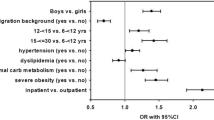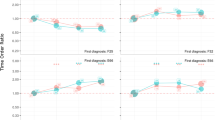Abstract
OBJECTIVE: To compare rates of DSM-IV psychiatric disorders between (1) a clinical study group of extremely obese adolescents and young adults, (2) gender-matched population-based obese controls and (3) a population-based control group of the same age range.
DESIGN: Rates of psychiatric disorders were assessed in (1) the clinical study group of obese adolescents and (2) the population based sample of obese adolescents, and compared to (3) a large population-based control group using a standardized psychiatric interview.
SUBJECTS: (1) Clinical study group: 30 female and 17 male extremely obese adolescents and young adults (age range: 15–21 y; mean BMI:42.4 kg/m2). (2) Thirty females and 17 males with the highest BMI (age range 15–21 y; mean BMI:29.8 kg/m2) of a population-based control group encompassing 1655 (805 males) adolescents and young adults. (3) The population based control group excluding the 30 females and 17 males with the highest BMI (n=1608; 788 males).
MEASUREMENTS: Munich-Composite International Diagnostic Interview (M-CIDI) allowing for DSM-IV diagnoses.
RESULTS: High rates of mood, anxiety, somatoform and eating disorders were detected in the clinical sample of obese adolescents which exceeded those observed in population controls (all P-values<0.01). Rates between population-based obese adolescents and young adults and population controls did not differ. In most patients the psychiatric disorders set in after onset of obesity. 57% and 35% of the female and male patients, respectively, reported eating binges with lack of control. However, less than one-half of these patients qualified for a DSM-IV diagnosis of an eating disorder.
CONCLUSIONS: Extremely obese adolescents and young adults who seek long-term inpatient treatment have a high lifetime prevalence for affective, anxiety, somatoform and eating disorders. Because the mean BMI of the clinical study group was considerably higher than that of the obese population controls, we were not able to clarify whether the high rate of psychopathology in the study group was related to the extreme obesity or to their treatment-seeking behavior.
This is a preview of subscription content, access via your institution
Access options
Subscribe to this journal
Receive 12 print issues and online access
$259.00 per year
only $21.58 per issue
Buy this article
- Purchase on Springer Link
- Instant access to full article PDF
Prices may be subject to local taxes which are calculated during checkout

Similar content being viewed by others
References
Hopkinson LC, Bland RC . Depressive syndromes in grossly obese women Can J Psychiatry 1982 27: 213–215.
Gertler R, Ramsey-Stewart G . Pre-operative psychiatric assessment of patients presenting for gastric bariatric surgery (surgical control of morbid obesity) Aust N Z J Surg 1986 56: 157–161.
Goldsmith SJ, Anger-Friedfeld K, Beren S, Rudolph D, Boeck M, Aronne L . Psychiatric illness in patients presenting for obesity treatment Int J Eat Disord 1992 12: 63–71.
Black DW, Goldstein RB, Mason EE . Prevalence of mental disorder in 88 morbidly obese bariatric clinic patients Am J Psychiat 1992 149: 227–234.
Hafner RJ, Watts JM, Rogers J . Psychological status of morbidly obese women before gastric restriction surgery J Psychosom Res 1987 31: 607–612.
Rand CS, Kuldau JM . Morbid obesity: a comparison between a general population and obesity surgery patients Int J Obes Relat Metab Disord 1993 17: 657–661.
Halmi KA, Long M, Stunkard AJ, Mason E . Psychiatric diagnosis of morbidly obese gastric bypass patients Am J Psychiat 1980 137: 470–472.
Friedman MA, Brownell KD . Psychological correlates of obesity: moving to the next research generation Psychol Bull 1995 117: 3–20.
Kuczmarski RJ . Prevalence of overweight and weight gain in the United States Am J Clin Nutr 1992 55 (Suppl): 495S–502S.
Hebebrand J, Remschmidt H . Anorexia nervosa viewed as an extreme weight condition: genetic implications Hum Genet 1995 95: 1–11.
Wadden TA, Foster GD, Letizia KA, Wilk JE . Metabolic, anthropometric, and psychological characteristics of obese binge eaters Int J Eat Disord 1993 14: 17–25.
Spitzer RL, Devlin MJ, Walsh BT, Hasin D, Wing R, Marcus M, Stunkard AJ, Wadden T, Yanovski S, Agras WS, Mitchell J, Nonas C . Binge eating disorder: a multisite field trial of the diagnostic criteria Int J Eat Disord 1992 11: 191–204.
Yanovski SZ, Nelson JE, Dubbert BK, Spitzer R . Association of binge eating disorder and psychiatric comorbidity in obese subjects Am J Psychiat 1993 150: 1472–1479.
Kuehnel RH, Wadden TA . Binge eating disorder, weight cycling, and psychopathology Int J Eat Disord 1994 15: 321–329.
Mussel MP, Peterson CB, Weller CL, Crosby RD, de Zwaan M, Mitchell JE . Differences in body image and depression among obese women with and without binge eating disorder Obes Res 1996 4: 431–439.
Berkowitz R, Stunkard AJ, Stallings VA . Binge-eating disorder in obese adolescent girls Ann NY Acad Sci 1993 699: 200–206.
American Psychiatric Association . Diagnostic and Statistical Manual of Mental Disorders (3rd edn revised) American Psychiatric Association: Washington, DC 1987.
American Psychiatric Association . Diagnostic and Statistical Manual of Mental Disorders (4th edn) American Psychiatric Association: Washington, DC 1994.
Isnard-Mugnier P, Vila G, Nollet-Clemencon C, Vera L, Rault G, Mouren-Simeoni MC . Etude contrôlée des conduits alimentaires et des manifestations émotionnelles dans une population d'adolescentes obèses Arch Fr Pediatr 1993 50: 479–484.
Wadden TA, Foster GD, Stunkard AJ, Linowitz JR . Dissatisfaction with weight and figure in obese girls: discontent but not depression Int J Obes 1989 13: 89–97.
Wallace W, Sheslow D, Hassink S . Obesity in children: a risk for depression Ann NY Acad Sci 1993 699: 301–303.
Sheslow D, Hassink S, Wallace W, de Lancey E . The relationship between self-esteem and depression in obese children Ann NY Acad Sci 1993 699: 289–291.
French SA, Perry CL, Leon GR, Fulkerson JA . Self-esteem and change in body mass index over 3 y in a cohort of adolescents Obes Res 1996 4: 27–33.
Wittchen HU, Beloch E, Garczynski E, Holly A, Lachner G, Perkonigg A, Pfütze EM, Schuster P, Vodermaier A, Vossen A, Wunderlich U, Zieglgänsberger S . Münchener Composite International Diagnostic Interview (M-CIDI, Paper-pencil and CAPI version 2.2, 2/95, English) Max-Planck-Institut für Psychiatrie, Klinisches Institut (Eigendruck), Munich 1995.
Wittchen HU, Nelson CB, Lachner G . Prevalence of mental disorders and psychosocial impairments in adolescent and young adults Psychol Med 1998 28: 109–126.
Hebebrand J, Himmelmann GW, Heseker H, Schäfer H, Remschmidt H . Use of percentiles for the body mass index in anorexia nervosa: diagnostic, epidemiological, and therapeutic considerations Int J Eat Disord 1996 19: 359–369.
Acknowledgements
We thank the patients for their participation. This study was supported by the Deutsche Forschungsgemeinschaft and the European Community.
Author information
Authors and Affiliations
Corresponding author
Rights and permissions
About this article
Cite this article
Britz, B., Siegfried, W., Ziegler, A. et al. Rates of psychiatric disorders in a clinical study group of adolescents with extreme obesity and in obese adolescents ascertained via a population based study. Int J Obes 24, 1707–1714 (2000). https://doi.org/10.1038/sj.ijo.0801449
Received:
Revised:
Accepted:
Published:
Issue Date:
DOI: https://doi.org/10.1038/sj.ijo.0801449
Keywords
This article is cited by
-
Two-Year Study on the Impact of Sleeve Gastrectomy on Depressive and Anxiety Symptoms in Adolescents and Young Adults with Moderate to Severe Obesity
Obesity Surgery (2024)
-
Mental health in children and adolescents with overweight or obesity
BMC Public Health (2023)
-
Gut microbiota and BMI throughout childhood: the role of firmicutes, bacteroidetes, and short-chain fatty acid producers
Scientific Reports (2022)
-
Psychiatric Co-morbidities and Body Shape Dissatisfaction in Adolescents with Obesity – A School Based Case Controlled Study
The Indian Journal of Pediatrics (2021)
-
Health related quality of life associated with extreme obesity in adolescents – results from the baseline evaluation of the YES-study
Health and Quality of Life Outcomes (2020)



